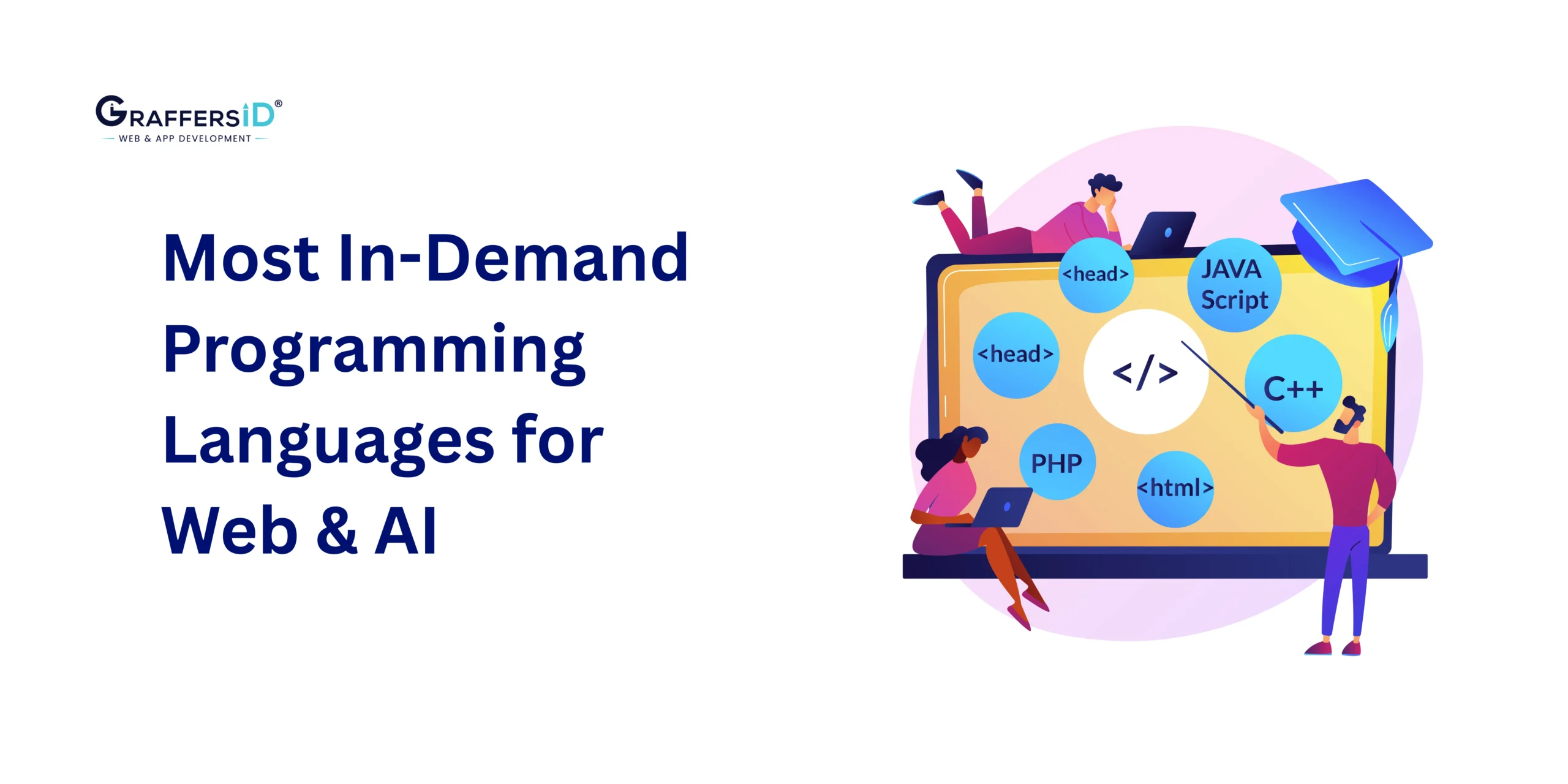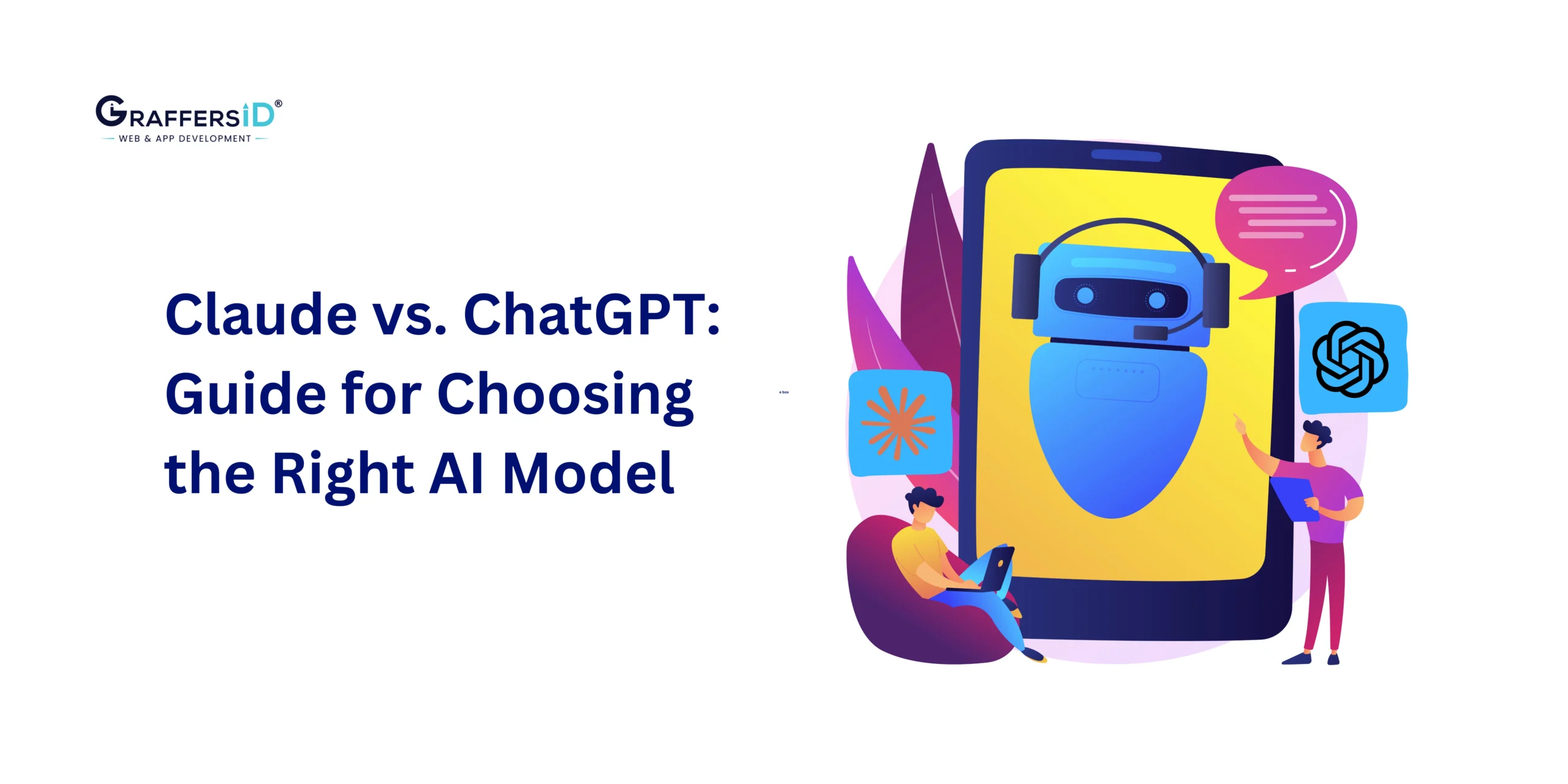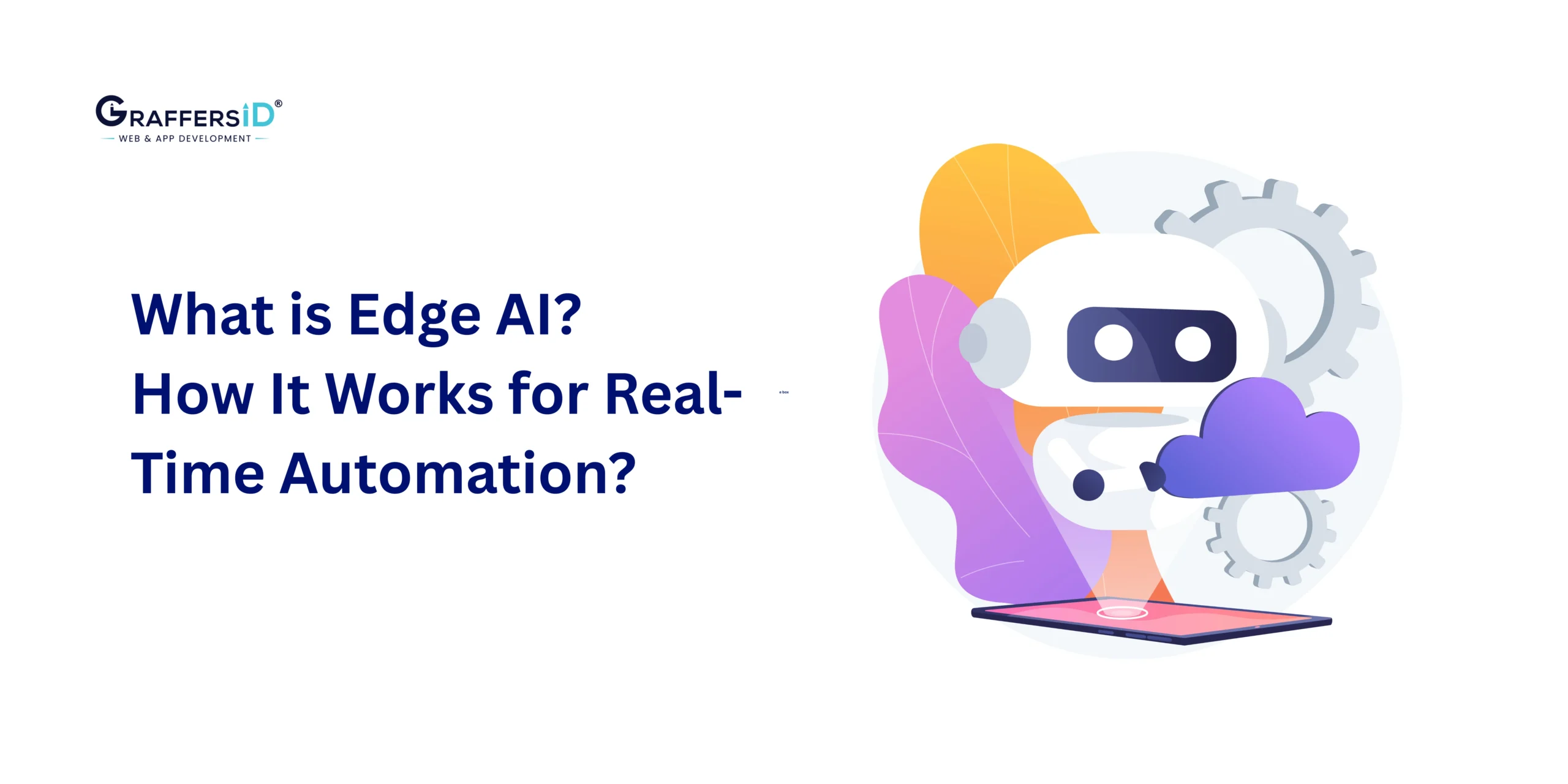What Makes a Programming Language In-Demand in 2026?
A programming language is considered in-demand today if it:- Powers AI-enabled and automation-driven products
- Supports scalable web, mobile, and SaaS applications
- Has a strong developer ecosystem and enterprise adoption
- Integrates easily with LLMs, APIs, and cloud platforms
- Is actively used by startups, enterprises, and global tech firms
Types of Programming Languages (High-Level vs. Low-Level)
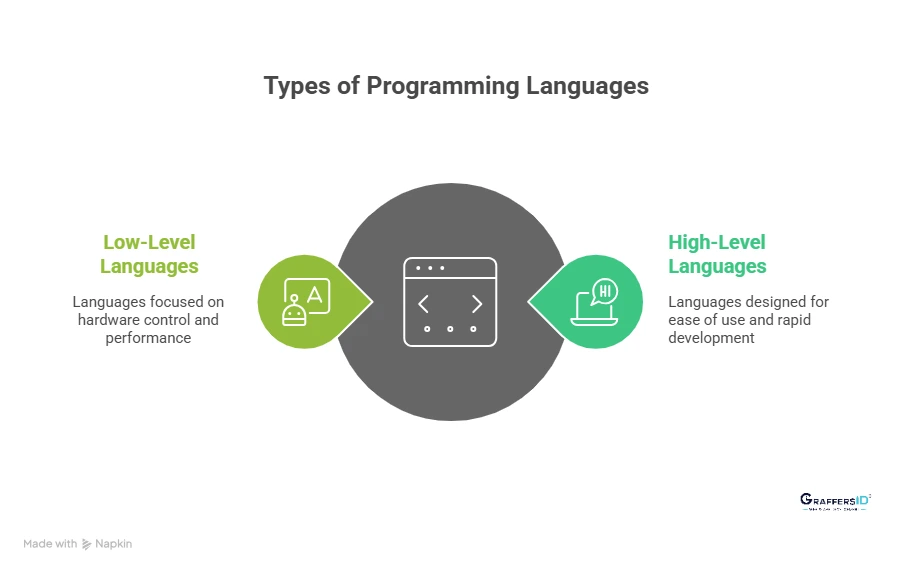
1. High-Level Programming Languages (Used in Most Software Today)
High-level programming languages are designed to be easy for humans to read, write, and maintain. Their syntax closely resembles everyday language, which allows developers to build applications faster without worrying about hardware-level complexity.
In 2026, most modern applications are built using high-level languages because they support rapid development, scalability, AI integration, and cross-platform compatibility.
Common High-Level Programming Languages
-
JavaScript: Powers interactive web applications and modern frontends
-
Python: Widely used for AI, automation, and backend development
-
Java: Preferred for large-scale and enterprise-grade systems
-
TypeScript: Adds structure and safety to JavaScript for scalable apps
-
Go (Golang): Used for high-performance backend services and APIs
Where High-Level Languages Are Commonly Used?
-
Web and mobile application development
-
SaaS and startup products
-
AI-powered and automation-driven systems
-
Enterprise software and digital platforms
These languages dominate hiring demand in 2026 because they enable faster time-to-market and long-term maintainability.
2. Low-Level Programming Languages (Hardware-Focused and Performance-Critical)
Low-level programming languages work closer to the hardware and system architecture. They give developers greater control over memory, processing, and performance, but require deeper technical expertise.
While they are not commonly used for everyday app development, low-level languages remain critical for system-level and performance-sensitive software.
Common Low-Level Programming Languages
-
Assembly Language: Directly interacts with hardware instructions
-
Machine-Level Languages: Binary instructions executed by CPUs
-
C / C++ (Partially Low-Level): Used where performance and memory control matter
Where Low-Level Languages Are Used?
-
Operating systems and kernels
-
Device drivers and embedded systems
-
Performance-critical software (gaming engines, real-time systems)
-
System utilities and hardware-level programming
In 2026, low-level languages are primarily used by system engineers, embedded developers, and performance-focused teams, not general application developers.
8 Most Popular Programming Languages in 2026
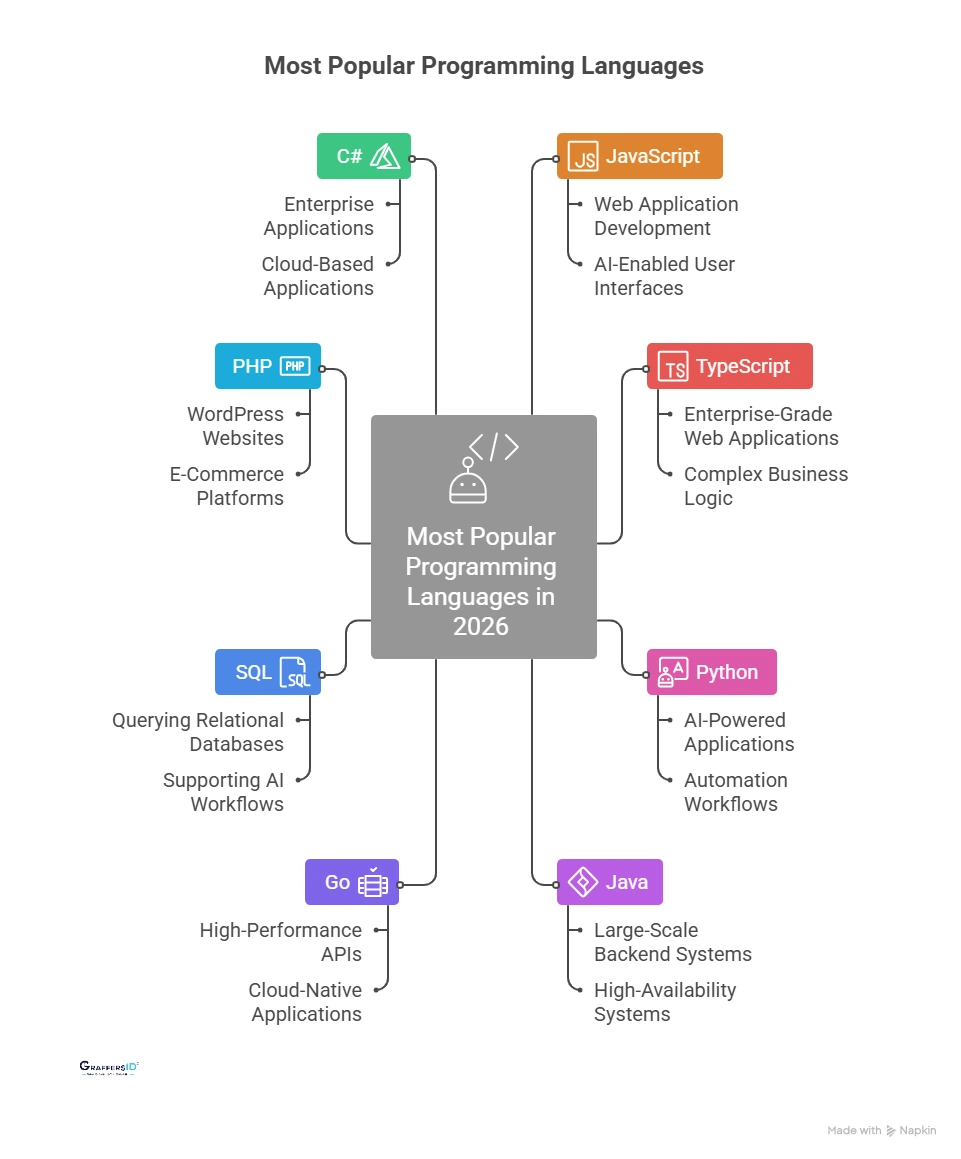
1. JavaScript: The Most In-Demand Language for Web & AI in 2026
JavaScript remains the foundation of modern application development in 2026. It is the only programming language that runs natively in web browsers while also powering backend servers, cloud functions, and edge applications. This unmatched versatility makes JavaScript the most widely adopted and hired-for programming language worldwide.
From interactive user interfaces to real-time data processing and AI-powered dashboards, JavaScript enables teams to build fast, scalable, and responsive digital products. Its ability to work smoothly across the frontend and backend reduces development complexity and accelerates product delivery, two critical factors for businesses in 2026.
Why JavaScript Remains Popular in 2026?
-
Runs across all environments: browser, server, cloud, and edge
-
Drives modern frameworks and libraries such as React, Next.js, Vue, Angular, and Node.js
-
Essential for AI-powered user interfaces, real-time analytics, and automation platforms
-
Supports headless CMS, composable architecture, and API-first development
-
Backed by the largest developer ecosystem and continuous innovation
Because of this flexibility, JavaScript is often the first choice for startups and enterprises building scalable digital products.
Common Use Cases of JavaScript in 2026
-
Web application development
-
SaaS platforms and dashboards
-
AI-enabled user interfaces and automation tools
-
Real-time applications (chat, analytics, collaboration tools)
For developers and businesses alike, JavaScript remains a future-proof investment and continues to dominate global hiring demand in 2026.
2. TypeScript: Best for Large-Scale JavaScript Applications in 2026
TypeScript has evolved from an optional JavaScript add-on into the standard language for building large, production-grade JavaScript applications. In 2026, most enterprise teams adopt TypeScript by default to manage growing codebases, distributed teams, and long-term product scalability.
Built and maintained by Microsoft, TypeScript adds static typing, better tooling, and compile-time error detection to JavaScript, significantly reducing runtime bugs and improving development efficiency.
Why is TypeScript Demand Growing Rapidly in 2026?
-
Type safety at scale: Catches errors during development rather than in production, improving code reliability.
-
Designed for long-term maintainability: Ideal for products expected to evolve over the years with multiple contributors.
-
Enterprise & startup adoption: Widely used by both fast-growing startups and large enterprises for mission-critical systems.
-
First-class support for modern frameworks: Works smoothly with React, Next.js, Angular, Vue, and Node.js.
-
Better developer experience: Strong IDE support, auto-completion, refactoring, and documentation generation.
Common Use Cases of TypeScript in 2026
-
Enterprise-grade web applications
-
Fintech, healthtech, and compliance-heavy platforms
-
SaaS products with complex business logic
-
Large frontend and backend JavaScript codebases
In 2026, TypeScript is no longer just a “nice-to-have”; it’s a strategic choice for teams building scalable, AI-ready, and production-critical JavaScript applications.
3. Python: The Most Used Language for AI, Automation & Web in 2026
Python continues to be one of the most in-demand programming languages in 2026, especially for businesses building AI-powered, automation-driven, and data-intensive applications. Its simplicity, flexibility, and strong ecosystem make it the first choice for both startups and enterprises.
Unlike many languages that specialize in one area, Python is widely adopted across AI development, backend systems, scripting, and workflow automation, making it highly versatile and future-proof.
Why Python is Still Popular in 2026?
-
Primary language for AI and LLM-based applications: Python is the most commonly used language for building AI agents, integrating large language models (LLMs), and developing intelligent automation systems.
-
Ideal for automation and backend development: From task automation and process orchestration to scalable backend APIs, Python enables rapid development with minimal complexity.
-
Easy to learn and maintain: Its clean syntax reduces development time and lowers the learning curve, making it easier to scale teams and onboard developers.
-
Massive ecosystem and community support: Python offers thousands of mature libraries and frameworks, ensuring long-term stability and faster implementation.
-
Strong adoption across startups and enterprises: Python is used by tech startups, SaaS companies, and global enterprises alike, making Python developers highly employable in 2026.
Common Use Cases of Python in 2026
-
AI-powered applications and intelligent agents
-
Automation workflows and business process automation
-
Backend development for web and SaaS platforms
-
API development and system integrations
Python’s dominance in AI and automation ensures it remains a top programming language choice for 2026 and beyond, especially for teams focused on innovation, scalability, and rapid product development.
4. Java: Best for Enterprise Applications in 2026
Java remains one of the most widely used programming languages for enterprise backend development in 2026. While newer languages continue to emerge, Java’s reliability, performance, and long-term support make it a preferred choice for organizations building scalable, secure, and high-traffic applications.
Enterprises across banking, fintech, eCommerce, logistics, and large SaaS platforms continue to rely on Java for mission-critical systems where stability and security are non-negotiable.
Why is Java Still Relevant in 2026?
-
Proven performance at scale: Java handles large workloads efficiently, making it ideal for applications with millions of users and high transaction volumes.
-
Strong security and compliance support: Java is widely used in regulated industries due to its mature security frameworks and long-term update cycles.
-
Robust enterprise ecosystem: Frameworks like Spring Boot, Hibernate, and Jakarta EE simplify the development of Java microservices and backend APIs.
-
Excellent support for microservices architecture: Java integrates smothly with modern backend patterns, REST APIs, and service-based architectures.
-
Large global talent pool: Hiring Java backend developers remains easier and more cost-effective compared to niche enterprise languages.
Common Use Cases of Java in 2026
-
Large-scale backend systems
-
Enterprise web and SaaS applications
-
Banking, fintech, and payment platforms
-
E-commerce and high-availability systems
-
Microservices-based backend architectures
5. Go (Golang): Fast & Efficient Backend Language for Scalable Systems in 2026
Go, also known as Golang, has emerged as one of the most in-demand backend programming languages in 2026 for building fast, reliable, and scalable software systems. Originally developed by Google, Go is designed to handle high concurrency and heavy workloads with minimal complexity.
Its clean syntax, strong performance, and built-in support for parallel processing make it a preferred choice for companies building cloud-native applications, APIs, and distributed systems.
Why Go (Golang) is in High Demand in 2026?
-
Built-in concurrency support using goroutines, making it ideal for handling thousands of simultaneous requests
-
High performance with low memory usage, suitable for large-scale backend systems
-
Simple and readable syntax, which reduces development time and onboarding costs
-
Fast compilation and execution, improving developer productivity
-
Widely adopted for cloud-native, containerized, and API-driven architectures
Go’s efficiency and reliability make it especially popular among startups and enterprises focused on scalability and system performance.
Common Use Cases of Go in 2026
Go is widely used for building:
-
High-performance REST and GraphQL APIs
-
Microservices and distributed backend systems
-
Scalable backend infrastructure for SaaS products
-
Cloud-native applications and server-side services
-
Networking tools and system-level backend components
In 2026, Golang is often chosen when performance, concurrency, and scalability are non-negotiable requirements.
Read More: 5 Best AI Frameworks and Libraries in 2026 Trusted by Leading Tech Companies
6. SQL: Essential for Database Management & Data-Driven Applications in 2026
Even with the rise of NoSQL databases, data lakes, and AI-driven analytics platforms, SQL remains a non-negotiable skill in 2026. Nearly every modern application, whether web, mobile, or SaaS, relies on SQL at some level to store, retrieve, and analyze structured data.
SQL continues to be the standard language for relational databases, making it essential for developers, data engineers, and analytics teams working on data-driven products.
Why is SQL Still Relevant in 2026?
-
Forms the backbone of data-driven application development
-
Widely used in analytics, reporting, and business intelligence systems
-
Supported by all major databases like MySQL, PostgreSQL, SQL Server, and cloud data platforms
-
Plays a critical role in AI, automation, and dashboard-driven decision-making
-
Remains one of the most requested skills in backend and data-related roles
As businesses increasingly rely on real-time insights and AI-powered features, SQL acts as the bridge between raw data and actionable intelligence.
Common Use Cases of SQL in 2026
-
Querying and managing relational databases
-
Backend data operations for web and SaaS applications
-
Reporting, analytics, and BI dashboards
-
Supporting AI and automation workflows with structured data
In short, while new database technologies continue to evolve, SQL is not being replaced; it’s being integrated deeper into modern tech stacks.
7. PHP: Popular for Web Development & Content Management Systems in 2026
Despite frequent debates about its relevance, PHP continues to power a large portion of the modern web in 2026. It remains one of the most widely used server-side programming languages, especially for content-driven and database-backed websites.
PHP’s longevity comes from its deep integration with popular platforms and its ability to deliver cost-effective, fast, and scalable web solutions, particularly for businesses that prioritize speed, content management, and lower development overhead.
Why is PHP Still Relevant in 2026?
-
Backbone of WordPress and CMS platforms: PHP powers WordPress, which alone supports over 40% of the web, along with popular CMS and eCommerce platforms like Drupal, Joomla, and WooCommerce.
-
Cost-effective web development: PHP offers lower hosting and development costs compared to many modern stacks, making it a practical choice for startups, SMEs, and content-heavy businesses.
-
Fast development for content-driven websites: Ideal for blogs, marketing websites, portals, and CMS-based platforms where quick iteration and performance matter.
-
Large developer ecosystem: A massive global PHP developer community ensures easy hiring, long-term support, and continuous updates.
-
Modern PHP frameworks improve scalability: Frameworks like Laravel and Symfony have modernized PHP, enabling cleaner architecture, better security, and scalable backend development.
Common Use Cases of PHP in 2026
-
WordPress and CMS-based websites
-
E-Commerce platforms and content portals
-
Business websites and marketing platforms
-
Backend systems for database-driven applications
PHP may not be the first choice for AI-heavy or real-time systems, but it remains a reliable and practical option for web development where speed, stability, and cost efficiency are priorities.
8. C#: Best for Enterprise & Microsoft Ecosystem Development in 2026
C# continues to be a reliable and in-demand programming language in 2026, particularly for businesses building applications within the Microsoft and .NET ecosystem. Known for its strong typing, security features, and scalability, C# is widely used for developing enterprise-grade, business-critical software.
With ongoing advancements in .NET Core and .NET 8+, C# supports cross-platform development, allowing applications to run smoothly on Windows, Linux, and macOS, making it more flexible than ever.
Why C# Is Still Relevant in 2026?
-
Deep integration with the Microsoft .NET framework
-
Strong performance and memory management
-
Ideal for long-term, scalable enterprise systems
-
Excellent tooling support through Visual Studio
-
Commonly used in corporate and regulated industries
Common Use Cases of C# in 2026
-
Enterprise applications and internal business software
-
Web applications built with ASP.NET Core
-
Cloud-based applications on Microsoft platforms
-
Financial, healthcare, and corporate systems
-
Desktop applications and line-of-business tools
C# remains a preferred choice for organizations that value stability, security, and structured development, especially when working with Microsoft technologies.
How to Choose the Best Programming Language in 2026?
Choosing a programming language in 2026 is no longer about trends alone; it’s about matching technology with your product goals, scalability needs, and long-term business strategy. The right choice can reduce development costs, speed up delivery, and make future upgrades easier.
Before selecting a programming language, ask these critical questions:
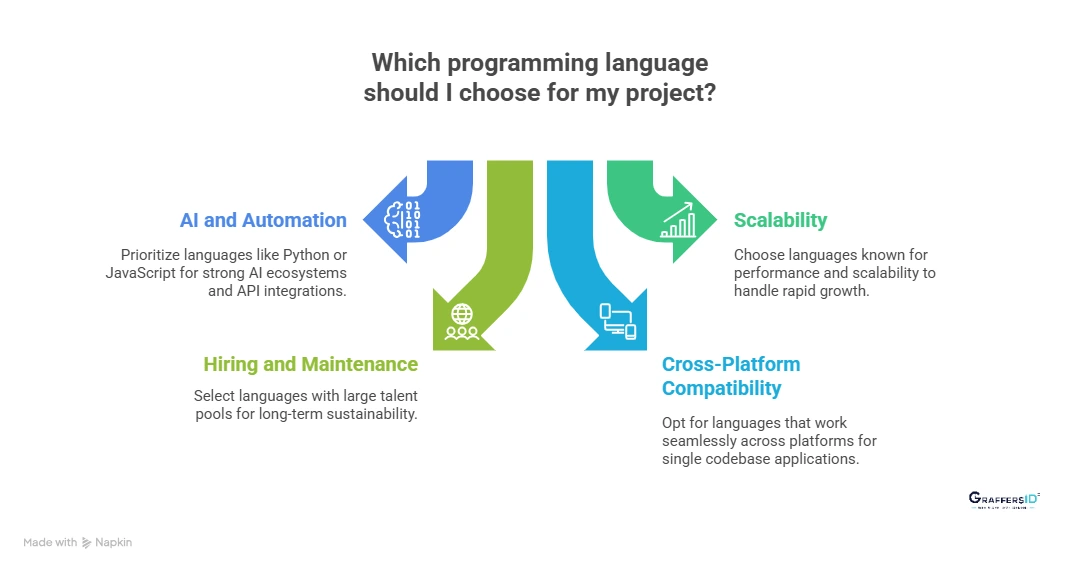
1. Are You Building an AI-Powered or Automation-Driven Product?
If your application relies on AI features, intelligent automation, or LLM integrations, prioritize languages that support strong AI ecosystems and API integrations, such as Python, JavaScript, or TypeScript.
2. Does Your Application Need to Scale Quickly?
For products expected to handle rapid user growth, high traffic, or real-time data, choose languages known for scalability and performance. This ensures your application can grow without frequent rewrites or performance bottlenecks.
3. How Important Is Long-Term Hiring and Maintenance?
A language may be powerful, but if developers are hard to find or expensive to hire, it can slow down your product roadmap. Languages with large global talent pools and active communities help ensure long-term sustainability.
4. Do You Need Cross-Platform Compatibility?
If your goal is to build web, mobile, or cross-platform applications from a single codebase, select languages that work smoothly across platforms and frameworks.
Conclusion: Choosing the Right Programming Language in 2026
The demand for programming languages in 2026 is shaped by AI adoption, automation-first development, scalability requirements, and digital-first business models. As technology continues to evolve, the most successful developers and businesses won’t chase every new trend; they’ll focus on languages that align with real-world use cases, long-term scalability, and future product growth.
There is no universal “best” programming language. The right choice depends on what you’re building, how fast you plan to scale, and the kind of talent you want to hire in the long run. By understanding current demand and future relevance, businesses can reduce technical debt, optimize development costs, and build products that remain competitive beyond 2026.
At GraffersID, we specialize in building future-ready web, mobile, and AI-enabled applications using the most in-demand programming languages.
Explore GraffersID’s services or connect with our experts today to hire top remote developers and build scalable, future-proof products.
